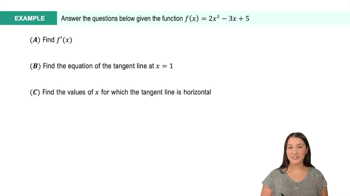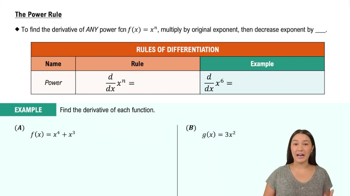Table of contents
- 0. Functions7h 52m
- Introduction to Functions16m
- Piecewise Functions10m
- Properties of Functions9m
- Common Functions1h 8m
- Transformations5m
- Combining Functions27m
- Exponent rules32m
- Exponential Functions28m
- Logarithmic Functions24m
- Properties of Logarithms34m
- Exponential & Logarithmic Equations35m
- Introduction to Trigonometric Functions38m
- Graphs of Trigonometric Functions44m
- Trigonometric Identities47m
- Inverse Trigonometric Functions48m
- 1. Limits and Continuity2h 2m
- 2. Intro to Derivatives1h 33m
- 3. Techniques of Differentiation3h 18m
- 4. Applications of Derivatives2h 38m
- 5. Graphical Applications of Derivatives6h 2m
- 6. Derivatives of Inverse, Exponential, & Logarithmic Functions2h 37m
- 7. Antiderivatives & Indefinite Integrals1h 26m
3. Techniques of Differentiation
Basic Rules of Differentiation
Problem 79
Textbook Question
Derivatives from a graph Let F = f + g and G = 3f - g, where the graphs of f and g are shown in the figure. Find the following derivatives.
<IMAGE>
G'(2)
 Verified step by step guidance
Verified step by step guidance1
Step 1: Understand the problem. We need to find the derivative of the function G at x = 2, where G is defined as G = 3f - g.
Step 2: Use the linearity of derivatives. The derivative of G, G'(x), can be found using the rule: G'(x) = (3f - g)' = 3f'(x) - g'(x).
Step 3: Evaluate the derivatives of f and g at x = 2. From the graph, determine the slopes of the tangent lines to the curves of f and g at x = 2, which represent f'(2) and g'(2) respectively.
Step 4: Substitute the values of f'(2) and g'(2) into the expression for G'(2). This gives G'(2) = 3f'(2) - g'(2).
Step 5: Calculate G'(2) using the values obtained from the graph. This will give you the rate of change of G at x = 2.
Recommended similar problem, with video answer:
 Verified Solution
Verified SolutionThis video solution was recommended by our tutors as helpful for the problem above
Video duration:
5mPlay a video:
Was this helpful?

 3:59m
3:59mWatch next
Master Derivatives of Linear Functions with a bite sized video explanation from Callie
Start learningRelated Videos
Related Practice







